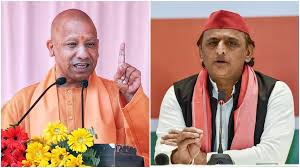Digital News Guru Uttar Pradesh Desk:
Today, Uttar Pradesh (UP) witnessed voting in 9 assembly constituencies as part of ongoing by-elections across several states in India. These constituencies, including Karhal, Meerapur, and Ghaziabad, represent key battlegrounds between prominent political parties, particularly the BJP and the Samajwadi Party (SP).
Significance of the By-Elections
The by-elections are critical in testing the political waters ahead of the 2025 state assembly elections. For the ruling Bharatiya Janata Party (BJP), it is an opportunity to consolidate its stronghold, while opposition parties, particularly the SP, aim to challenge the BJP’s dominance. The outcomes are expected to influence strategies for upcoming Lok Sabha elections.

Key Constituencies in Uttar Pradesh
- Karhal (Mainpuri District):
- Known as an SP bastion, Karhal is crucial for the opposition to maintain its grip. The SP is fielding strong candidates to counter BJP’s focused campaign.
- Meerapur (Muzaffarnagar District):
- Voting witnessed some disruptions, with police intervening to manage crowd disturbances. Meerapur’s diverse voter base adds to its importance for both major parties.
- Ghaziabad:
- With 14 candidates in the fray, Ghaziabad holds strategic importance due to its urban demographic and proximity to Delhi. BJP’s performance here could signal its urban appeal’s current strength.
Trends and Voter Turnout
Early voter turnout numbers varied across constituencies. Katehari recorded 11.48%, while Ghaziabad and Sisamau had lower turnout at 5.36% and 5.73%, respectively. Kundarki led with 13.59%, showing significant local interest in the elections. Such numbers may reflect urban-rural divides in voter engagement.
Broader Context
The by-elections are part of a larger national exercise covering 31 assembly seats across 10 states. For Uttar Pradesh, where nine seats are up for grabs, the contest mirrors the intensifying political rivalry between the BJP and the opposition alliance (INDIA bloc). While the BJP relies on its developmental narrative, the SP emphasizes grassroots issues like inflation and unemployment.
Challenges and Observations
- Low Urban Turnout: Urban constituencies like Ghaziabad showed low early voting percentages, raising concerns about voter apathy in cities.
- Administrative Hiccups: The police action in Meerapur highlights the challenges in maintaining peaceful voting in sensitive areas.
- Polarized Campaigning: Both major parties are focusing on sharp, targeted messaging to sway undecided voters.
Implications
The results of these by-elections will not only determine immediate representation but also set the stage for broader political contests in 2025 and 2026. While the BJP seeks to retain its momentum, opposition parties like the SP aim to make a dent in its dominance in India’s most populous state.

Political Stakes
The elections are crucial for multiple reasons:
- BJP’s Test of Dominance: The BJP’s stronghold over Uttar Pradesh is integral to its national strategy. Securing wins in these by-elections would reinforce its narrative of sustained development and governance.
- Opposition’s Push for Relevance: The INDIA bloc, with the SP at the forefront in UP, is leveraging issues like inflation, unemployment, and farmers’ welfare. Wins in these constituencies would validate their positioning as a viable alternative.
- Caste and Community Dynamics: UP’s political ecosystem is deeply rooted in caste alignments. Parties are aligning their campaigns to address specific community grievances, such as Dalit and OBC representation.
Campaign Themes and Challenges
- Urban vs. Rural Divide: Urban regions such as Ghaziabad have witnessed lower engagement, raising concerns over voter apathy. Campaign strategies must address the disconnect between urban constituencies and political parties’ narratives.
- Security Concerns: Disruptions in Meerapur underline the logistical and administrative challenges of conducting peaceful elections. The Election Commission has intensified efforts to prevent further incidents.
- Narrative Battle: While the BJP emphasizes its development agenda, opposition parties have targeted socio-economic disparities and governance lapses. This contest of ideologies is at the heart of the elections.
Broader Implications
The results of these by-elections will carry implications far beyond the contested constituencies:
- Setting the Tone for 2025 Assembly Polls: A victory for the BJP could cement its strategy for retaining power in UP, while wins for the opposition could disrupt the ruling party’s momentum.
- Influence on National Elections: As India’s most populous state, UP plays a decisive role in shaping the outcome of general elections. The performance of both major alliances here will provide insight into voter sentiments ahead of 2024.
- Shift in Voter Sentiments: These elections offer a glimpse into evolving political preferences, especially among youth and urban populations, who are increasingly critical stakeholders.
Conclusion
The by-elections in Uttar Pradesh encapsulate the dynamic interplay of grassroots politics, urban challenges, and caste dynamics. As results are awaited, the contests represent a microcosm of India’s broader democratic processes. The final outcomes will offer a clearer picture of whether the BJP maintains its dominance or if the opposition bloc successfully positions itself as a formidable challenger.
Stay tuned for November 23, when the results will provide a definitive answer to these pressing political questions.
You May Also Read: Maharashtra and Jharkhand Elections 2024: Key Highlights and Voter Trends








